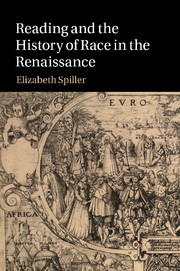Book contents
- Frontmatter
- Contents
- Acknowledgements
- Introduction: Print Culture, the Humoral Reader, and the Racialized Body
- 1 Genealogy and race after the Fall of Constantinople: From The King of Tars to Tirant lo Blanc and Amadis of Gaul
- 2 The form and matter of race: Aethiopika, hylomorphism, and neo-Aristotelian readers
- 3 The conversion of the reader: Ariosto, Herberay, Munday, and Cervantes
- 4 Pamphilia's black humor: reading and racial melancholy in the Urania
- Notes
- Index
4 - Pamphilia's black humor: reading and racial melancholy in the Urania
Published online by Cambridge University Press: 01 June 2011
- Frontmatter
- Contents
- Acknowledgements
- Introduction: Print Culture, the Humoral Reader, and the Racialized Body
- 1 Genealogy and race after the Fall of Constantinople: From The King of Tars to Tirant lo Blanc and Amadis of Gaul
- 2 The form and matter of race: Aethiopika, hylomorphism, and neo-Aristotelian readers
- 3 The conversion of the reader: Ariosto, Herberay, Munday, and Cervantes
- 4 Pamphilia's black humor: reading and racial melancholy in the Urania
- Notes
- Index
Summary
Lady Mary Wroth's remarkable two-part romance, the printed The Countesse of Mountgomerie's Urania (1621) and its manuscript sequel, The Secound Part of the Countess of Montgomerys Urania, provides a key endpoint to this story about how the practice of reading and the history of racial identity developed within printed romances of the sixteenth and seventeenth centuries. Discussions of race and Lady Mary Wroth understandably often begin with Wroth's performance in Ben Jonson's “Masque of Blackness” at Whitehall in January, 1605, where she, Queen Anne, and ten other ladies of the court played the roles of the daughters of Niger in a controversial and much commented-upon performance. Kim Hall thus sees Wroth as “deeply implicated” in the production of a “persistent presence of a discourse of blackness in James' court” and frames her discussion of the Urania through the perspective of Wroth's role in Jonson's masque. Critical attention to the implications of Wroth and the Queen's other ladies performing with “black faces and hands … painted and bare up to the elbows” are consistent with the dominant theatrically-inflected models for understanding racial difference in terms of embodied encounters that I discussed in the Introduction.
Here, though, I would like to approach the topic of identity and racial difference in the Urania as it emerges not out of performance practices but out of reading experiences. Mary Wroth was a reader. As a reader, she had almost unparalleled access to books.
- Type
- Chapter
- Information
- Reading and the History of Race in the Renaissance , pp. 153 - 201Publisher: Cambridge University PressPrint publication year: 2011



